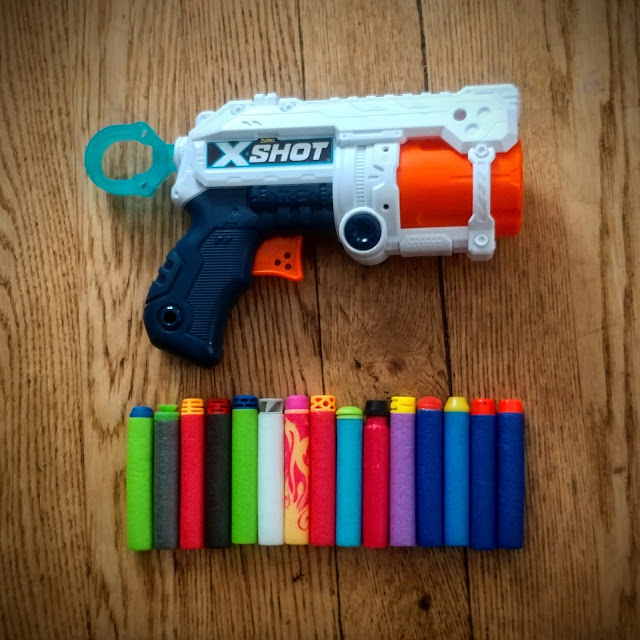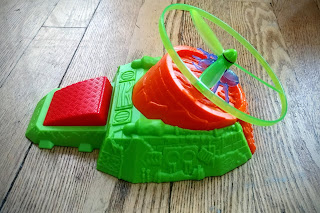Contents
This is a very simple blaster, and as such, there isn't a ton in the box. You get the blaster itself, along with 8 X-Shot darts. The blaster is once again held in with Zuru's cool plastic screws, keeping the blaster secure in the packaging, yet easy to remove, without there being any ties going across it. The downside of these is that they require extra holes in the shell. On this blaster, there are two extra holes in the shell that run all the way through from one side to the other.
I do very much appreciate the fact that Zuru packages more darts than the blaster holds with each blaster, there's nothing worse than getting a new blaster, losing one dart and then not being able to fully fill it. Including twice the number of darts than the blaster holds is a very nice touch.
Overview
Much like the Swarm Seeker, one of the first things that stands out about this blaster is how light it is. The plastic is the usual X-Shot quality, and like the other X-Shot blasters there are tons of cool looking details all over. The blaster is a very simple design, with a 4-dart auto rotating cylinder in the front, and a simple pull back priming mechanism. The cylinder rotates on the prime, and seems to line up and index properly every time. The draw length is pretty decent for a blaster this size, and the priming handle is nicely rounded and easy to pull. The blaster's grip is a bit small for my hands, but since its a small blaster overall, this is to be expected. While small, it isn't uncomfortable, but my pinky does end up kinda falling off the bottom of it.
Build Quality
Like any other X-Shot product, the plastic quality is decent. It doesn't feel nearly as sturdy as Nerf construction, but it doesn't feel creaky and cheap like some Buzz Bee blasters. The blaster uses stickers, which I'm never a fan of, and one of the stickers on my blaster was put on at an angle, adding a slightly cheaper feel.
Everything on the blaster feels solid and well made, despite being lightweight and somewhat cheap. Nothing particularly stands out as being amazing or terrible, it is good enough that you won't feel like it could break, but it doesn't feel like it could survive being thrown around all the time either.
Build Quality Grade: B-
Aesthetics
As I said in my Swarm Seeker review, I personally really like the aesthetic of the more recent X-Shot blasters, and the Fury 4 is no exception. The blaster just looks cool. The recent X-Shot designs have all had a slightly sci-fi feel to them, which I really like. The blaster actually has front and rear iron sights, although they're pretty tiny, and like with all blasters, not very useful. There is a fake tactical rail on top, which looks cool, but I'm not really sure why Zuru is still putting on fake tactical rails when they do have blasters with real tactical rails and accessories. The shell has a TON of cool little details, and it'll be very fun to paint one of these days. I like the color choice too, the white and dark blue with a bit of transparent blue for the priming handle looks futuristic, while still looking like a toy. Overall, the designers did a fantastic job with this blaster, and it is definitely one of the nicest looking pistols you can get.
Aesthetics Grade: A
Performance
You might think that as a tiny, 4 shot pistol, this blaster wouldn't perform as well as the larger blasters in the X-Shot lineup, but that couldn't be further from the truth. In my own chronograph testing, I found that with the X-Shot darts it came with, it shot consistently around 78 FPS, and with other darts it was getting around 70. With an assortment of darts, I got an overall average of 70 FPS. However, my results were somewhat lower than others I've seen for this blaster, with many people claiming they had around 75 or higher with elites and 82 or so for the included darts. Even with my slightly lower numbers, the blaster performs quite well for its size. The similar Nerf Quadrant only shoots around 60 FPS. In my testing, the blaster was able to fire nearly every type of dart I own, with the predictable exception of old streamlines due to dart posts.
All of these darts fired out of this blaster just fine:
For a small backup pistol, the performance of the Fury 4 is very good, and it will consistently shoot as well if not better than most out of the box Nerf blasters.
Performance Grade: A-
Usability
The Fury 4, being a four shot revolver, is inherently not all that useful in a game. Obviously it can't be compared to a primary class blaster, but as far as pistols go, it is decent. If you want to carry a secondary, the Fury 4 doesn't have the best capacity, and there are many six shot revolvers that would be a better option. If you're looking for a small backup blaster though, the Fury 4 is a fantastic option. The biggest downside to carrying the Fury 4 in a game is that since there is nothing in front of the cylinder, the dart tips could be bent if it was put into a holster. If you use the included shorter X-Shot darts however, they barely stick out of the front. I wouldn't use the Fury 4 as my only blaster, but as mainly an HvZ player, I would certainly carry it as a backup to my primary.
Usability Grade: B
Mod Potential
This blaster, like the Swarm Seeker, is incredibly easy to open up. No parts are glued or difficult to get apart, and all the screws are the same size, making it easy to reassemble. Once you open the blaster, you can see that the plunger tube is rather short, but decently wide.
The other plunger tubes here are the Stampede and a BOOMco Dynamag:
The plunger head is held onto the plunger rod with one screw in the side, making it easy to replace the spring.
I tried a variety of springs, and none of the ones that I had fit into the blaster, being either too narrow for the plunger rod or too wide for the plunger tube. The AR is only held into the plunger tube with clips, so it can be removed without any trouble. The different color plastics on the body of the blaster come apart with one single clip per side, making the shell very easy to take apart to paint.
While I didn't have any luck replacing or adding to the spring, given the proper size spring, it should be quite easy to get even better performance out of this pistol, and due to the shell coming apart, it would be easy and fun to paint.
Mod Potential Grade: B-
Value For Money
When it comes to this category, X-Shot can't really be beaten. I purchased this blaster from Walmart for the full MSRP of $4.97. That's right, this 4 shot, auto-rotating, 75-80 FPS pistol with costs about the same amount as a Jolt. And it comes with twice its capacity of darts. There honestly isn't much more to say here. $5 for this blaster is ridiculously good. The Nerf Quadrant, which performs worse, looks worse, comes with fewer darts and has worse mod potential costs twice the price of this blaster. In our HvZ club we often say that everyone should own a Jolt, but why would you buy a Jolt when you can buy this instead?


































































